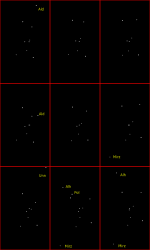[If this tangent is too distracting, please ask the Mods to delete this post, or hide it with Hide tags.]
Perverse perfectionism ranks somewhere on my List of 30 Biggest Faults. I am unable to proceed without posting a flaws-corrected version of the
Nine Views of Orion. Again the eight views other than the central view from Earth are taken every 45 degrees along a circle of radius 20 ly centered at earth and perpendicular to the Earth-Orion line.
Many more stars are shown than in the previous effort (263 stars over the nine pictures). A
bug feature is that faint stars are colored black or dark grey; they are visible in the image if magnified.
Here is a list of the 16 stars brighter than 2.4 which occur in these images. These include the 7 brightest stars in Orion, 7 stars shown with labels, the second brightest star of Castor (a sextuple-star system), and the second brightest star of Capella (a quadruple-star system). Amusingly(?) Capella's companion was BARELY in a viewing frame of my earlier effort, while Capella itself was NOT -- I didn't note the connection then and labeled this companion as "unnamed star."
The first number in the entries following shows how many of the 9 views contain the star; the second number is the star's relative magnitude.
CAP : 1 Capella [-0.6] alpha Aurigae
--- : 9 Rigel [0.2] beta Orionis
--- : 1 Capella companion [0.3]
--- : 9 Betelgeuse [0.4] alpha Orionis
POL : 1 Pollux [0.5] beta Geminorum
ALD : 2 Aldebaran [0.7] alpha Tauri
CAS : 1 Castor [1.1] alpha Geminorum
aln : 1 Alnath [1.5] beta Tauri
--- : 9 Bellatrix [1.6] gamma Orionis
--- : 9 Alnitak [1.7] zeta Orionis
--- : 9 Alnilam [1.7] epsilon Orionis
alh : 4 Alhena [1.9] gamma Geminorum
mir : 7 Mirzam [2.0] beta Canis Majoris
--- : 9 Saiph [2.1] kappa Orionis
--- : 9 Mintaka [2.3] delta Orionis
--- : 1 Castor-companion [2.4]
View attachment 33332
I have my own blog under a different name I keep separate from 'Swammerdami.' Therefore I never post both to my blog AND TalkFreeThought; and have therefore lost the opportunity of posting this to my blog.

I will avoid this mistake in future!



